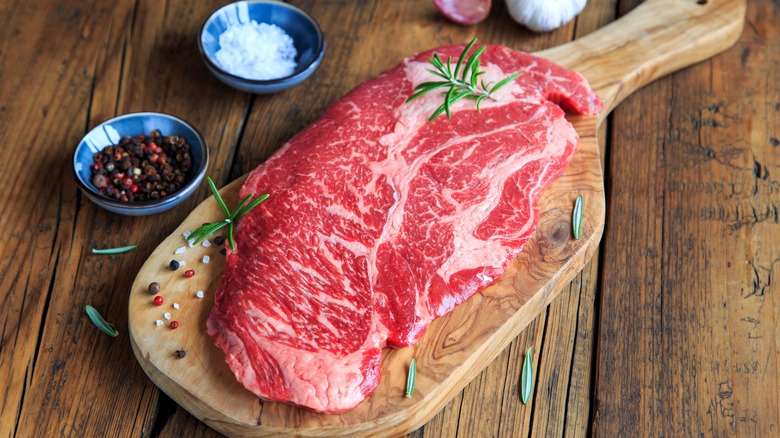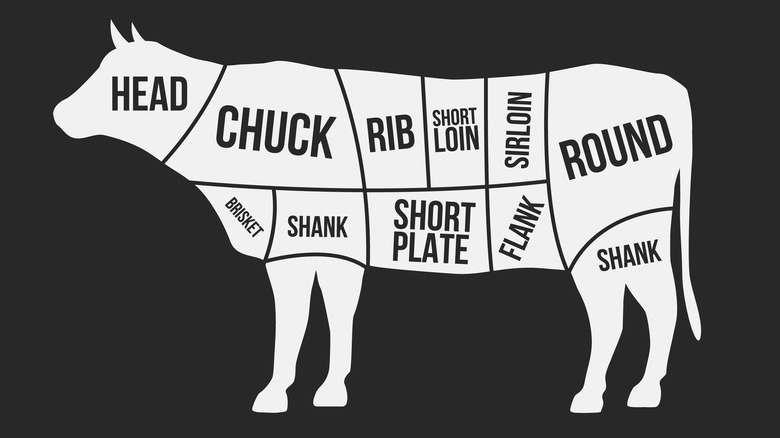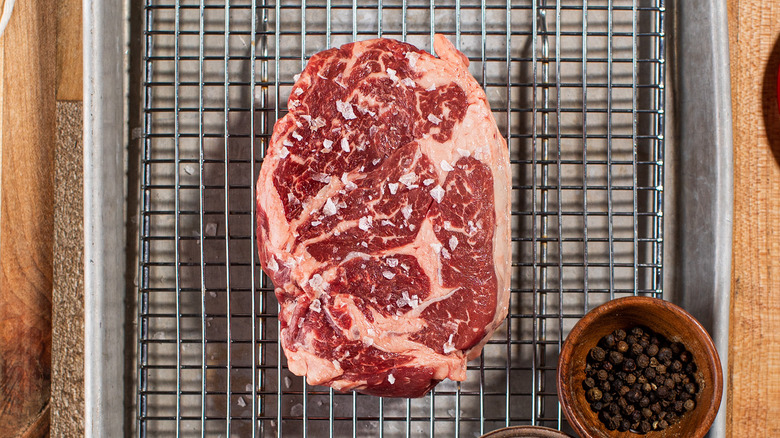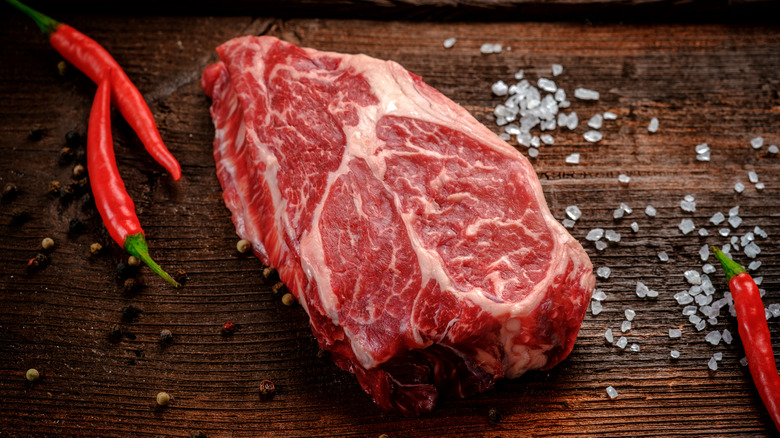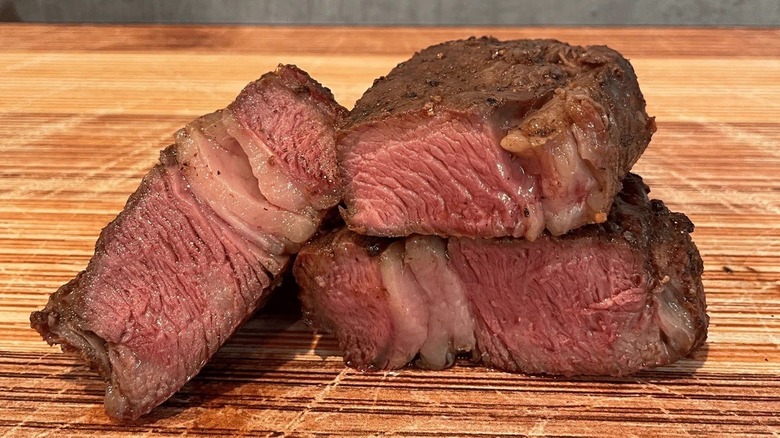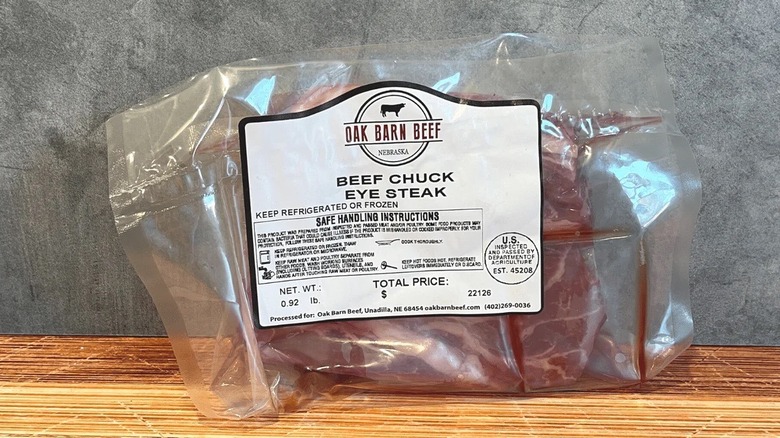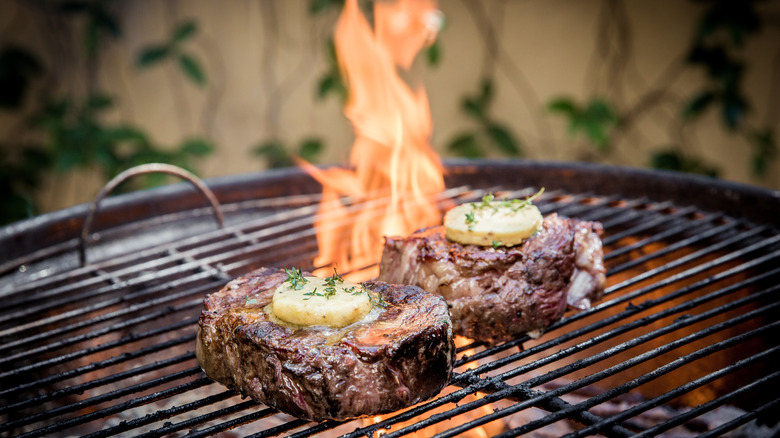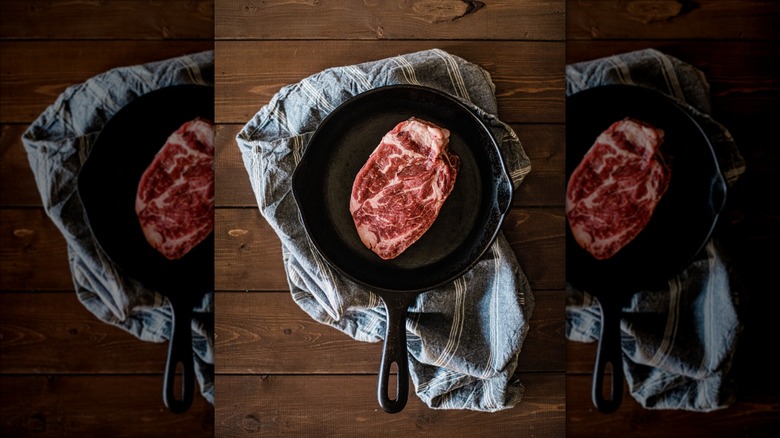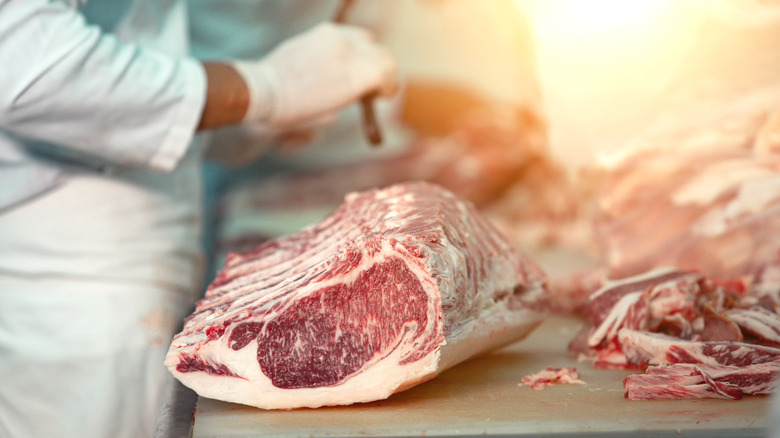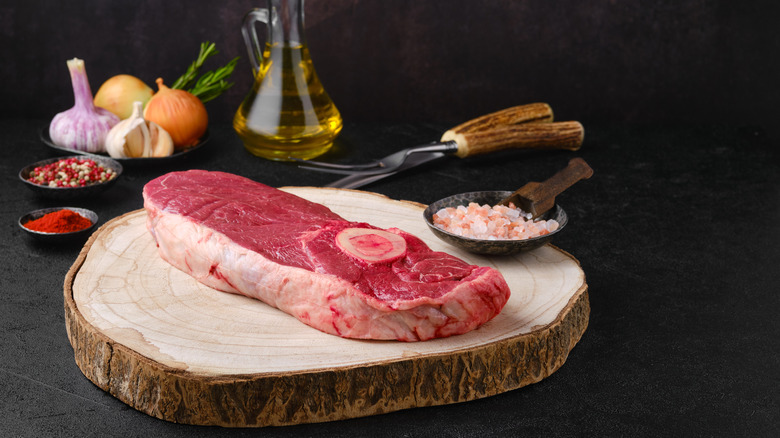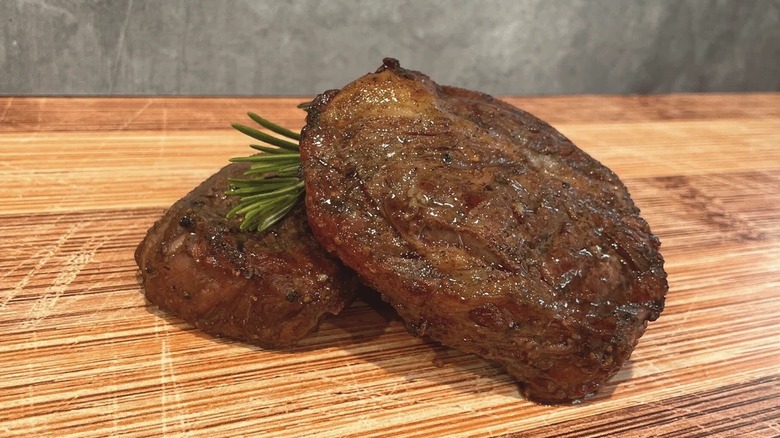Beef Experts Claim Chuck Eye Steak Deserves More Credit
Nothing epitomizes the summer grilling season quite like a beautifully cooked steak. Tender, beefy forkfuls of meat charred from the flame and seared to juicy, savory perfection are a highlight at any backyard cookout. But with skyrocketing beef prices, it can be difficult to fit steak into your grilling budget. While you might be used to paying an arm and a leg (and maybe a few other limbs) to shell out the money necessary to purchase ribeyes and other cuts of steak that rank among the best out there, some steaks can be just as tantalizing without the budget-breaking price tag.
Enter chuck eye steaks. They're next-door neighbors to the ribeyes on the cattle, which means they've got plenty of charming qualities you're used to in a premium steak cut. But they're lesser known and not quite as flashy, which means you can get them for a fraction of the price — if you know where to look and what to ask for.
Just because chuck eye steaks aren't quite so popular right now doesn't mean they won't be in the future. In fact, they're growing in popularity even within the last several months. We spoke with expert butchers and cattle producers who gave us the low-down about why chuck eye steaks deserve a second look — or a first one — the next time you're on the hunt for a succulent, crowd-pleasing cut of beef. Here's what they had to share.
Only one knife cut separates chuck eye steaks from ribeyes
To fully understand the magic of the chuck eye, we need to get nerdy about bovine anatomy for just a minute. When cattle are butchered, they are cut in specific ways to piece out the steaks you know and love. Cattle have 13 ribs, and ribs 6 to 12 are where ribeyes are cut from, said James Peisker, a chef and butcher who co-founded Porter Road. Porter Road began as a Nashville-based butcher shop that now ships its meat products across the 48 contiguous United States.
The chuck, or shoulder region of the cattle, begins at the fifth rib and goes all the way up into the neck. The chuck eye steaks are cut from that fifth rib, which means the only thing separating chuck eye steaks from ribeyes is the swipe of a knife blade. "It's one knife cut," Peisker explained. "On one side of that knife cut is a chuck, the other side is the rib."
Different butchers will cut different portions of that chuck area into chuck eye steaks. At Porter Road, each steer or heifer yields six 1-inch steaks. "When we bone out the chuck, we take those first 3 inches of the chuck roast and take out just the eye part, that same muscle that is the ribeye, and cut three steaks out of it," Peisker said. "It's the same muscle structure as the ribeye but farther up in the shoulder."
Chuck eye steaks are the most tender from the chuck region
There's a reason that traditional butchers avoided any area of the chuck or shoulder region for cutting steaks in the not-so-distant past, since it's an area that's known to be tougher than the muscles under the ribs. Any muscle on an animal that is used more often — like where the legs meet the body of a 1,200-pound steer — will by nature be at least slightly tougher than the meat that comes from lesser-exercised areas.
Previous methods of butchery would often include one big cut for the chuck region, Peisker said, which are often sold as chuck roasts or 7-bone roasts. But when butchers piece those different muscles apart, you can get chuck eyes, Denver steaks, Sierra steaks, boneless short ribs, and stew meat. Not all of those cuts should be cooked or treated the same, he added. "We're looking at everything from a chef's standpoint," Peisker said. "All the muscles together don't really cook up the same way and don't have the same characteristics."
Since chuck eyes are cut from the area right next to the ribs, an area of muscles the cattle don't use as often, it's the most tender portion of that shoulder region, said Hannah Klitz, a fifth-generation cattle producer and owner of Oak Barn Beef in Nebraska. "Chuck is known for being more tough, but the more tender part of that steak is the chuck eye," she said.
They're an incredibly flavorful cut
While using muscles more frequently means cuts like chuck eyes can be a tad tougher than other parts of the animal, Peisker said it also has a major advantage: Deeper, richer flavor permeates the meat. "The more the animal uses the muscle, the more flavorful it will become," he summarized. He compared chicken thighs to chicken breasts for the illustration: Chickens use their thighs much more to walk around, which leads to deeper color and flavor in the thighs compared to chicken breasts. Compared to some ribeyes and particularly strip steaks, Peisker said chuck eyes will often have a deeper, beefier flavor.
"At home, we cook chuck eyes a lot," Peisker said. "You will rarely ever see us do a filet. They're good ... but we don't mind a little bit of chew in our house, and we eat for the flavor." Klitz agreed, saying she's heard chuck eyes dubbed as "the poor man's ribeye" — but for good reason. "It's not quite as tender as a ribeye but it's pretty dang good and has a lot of good flavor in it, too," she said.
Chuck eyes have great marbling for extra flavor and juiciness
In addition to the beefy flavor that comes from chuck eyes, the fat marbling inside the steaks creates a juicy, craveable steak that both Peisker and Klitz rave about. The marbling in a chuck eye should be similar to what you'd see in a ribeye cut from the same steer, Peisker said, but there will be more fat deposits in the chuck eye. "It is well marbled so you have a tender, more of a melt-in your-mouth steak with it," Klitz said.
The makeup of the chuck eye is also worth noting since steak aficionados will appreciate certain features. While the center part — the eye itself — will be smaller than a ribeye, the spinalis will be larger. The spinalis is also known as the ribeye cap and curves around the eye, separated by a strip of fat. The spinalis, known for its tenderness and flavor, is chef Andrew Zimmern's favorite cut of steak. With chuck eyes, you'll get a bigger portion of that section than with most other cuts.
Those features mean you get a lot of bang for your buck, Peisker said. "It has a lot more of that spinalis, which is a really sought-after muscle but is rarely ever sold by itself," he reiterated. "And then it's interwoven with a bunch of fat. So it's going to have a lot of self-basting moisture that's going to create a really great succulent steak."
Chuck eye steaks are roughly half as expensive as ribeyes
While the similar features to ribeyes might have you thinking you'd need to shell out just as much money to try a chuck eye, think again. That "chuck" portion of the description can be enough to make people think twice, and the reality is that these steaks will still be slightly tougher than their ribeye neighbors.
That said, you can normally find chuck eyes for roughly half of what you'd pay for a ribeye — sometimes even less, depending on the size they're cut to. You might not find these widely available on grocery store shelves yet, but your local butcher likely has them — or can cut them for you. "It's a less expensive, great alternative to a ribeye steak," Peisker summarized. "If you're in the know, you can basically buy a ribeye for half the price."
For example, Oak Barn Beef sells its chuck eyes in packs of two 8-ounce steaks for $19.99. The company's boneless ribeye cuts, which are about 1.5 inches thick and 1-1.5 pounds, retail for $44.99 apiece. Porter Road has a similar price difference between its chuck eye and ribeye cuts. One chuck eye steak, which Peisker said is about 1 inch thick and 12 ounces, is listed for $22. The boneless ribeyes, which average about a pound each, sell for $38.
Chuck eyes are best cooked on the grill
Unlike many other cuts from the shoulder area, which need to be roasted or braised for optimal tenderness, chuck eyes are best when grilled. Klitz said her family's preferred method is to season them with salt or a favorite steak seasoning, and grill to medium rare (or 130 degrees Fahrenheit). If the steaks are frozen, you'll want to thaw them in the refrigerator a day ahead of time, and then bring them to room temperature by setting them out before grilling them. "That makes a big difference in the cooking process," Klitz said — a tip for cooking perfect steaks that's backed up by celebrity chefs like Gordon Ramsay.
Peisker agrees that grilling is the best way to enjoy a chuck eye steak, and he prefers to season simply with salt. His preferred temperature for chuck eyes is 135 to 140 degrees, a touch past medium-rare but not quite at medium. "You want to render a little bit more of that fat," Peisker explained.
As for the grilling itself, don't be afraid if the flames dance around the chuck eyes a bit. If you see that, it means you're doing it right, Peisker said. "You want that fire to flare up: That's why you choose the fattier cut, you want that char and that flavor and that little bit of burnt on the edges of those steaks," he explained. "You want that fire to kiss that steak to create that unmatched flavor."
They also have versatility for other cooking options
Though your first experience eating a chuck eye should ideally come from the grill, both Klitz and Peisker said the cut has enough versatility to cook it other ways and still be delicious. If you like your steak with a bit of a crust on it, Klitz said pan-searing it on the stovetop is also a great option. She uses butter and herbs to baste the steaks with this method, though you're still going for the same temperature for serving it.
Peisker said chuck eyes have another advantage: They can also be sliced thin and used as a cost-effective but still delectable cheesesteak. The best cheesesteaks use ribeye shaved thin in the sandwiches since the meat is tender and flavorful. But since chuck eyes share many of the same characteristics as ribeye cuts, you can get a product that will be almost indistinguishable for a fraction of the price.
Regardless of the method you use, Klitz cautioned that chuck eye steaks are typically smaller and thinner than ribeyes, so you'll need to keep a closer eye on them than thicker cuts of steak. (Oak Barn's chuck eyes are normally about three-quarters of an inch thick, Klitz explained, compared to about 1 ¼ inches thick for a ribeye.) If you do it right, though, your steak dinner will be ready even faster.
Chuck eyes can be a good way to test your butcher's quality
Choosing a good chuck eye is like choosing any other steak: You need to use your senses to judge the quality first, Peisker said. The chuck eye should look a lot like a ribeye you're more used to seeing, only with a smaller eye and larger spinalis.
Technically, butchers could cut "chuck eye" steaks farther up into the shoulder, Peisker said, though the eyes would continue to shrink and the cuts would get increasingly tougher. The quality of the meat and the integrity of what you're getting will depend on the butcher. "Know where you're buying it from," Peisker cautioned. "Make sure it's somebody reputable that you trust."
Klitz said specialty cuts like chuck eyes can indicate a good butcher — and high beef standards — than more popular, run-of-the-mill steaks. "Those steaks tell more about the cattle and quality you're getting," she said, and suggested that since chuck eyes are more affordable than some premium cuts, it could also be a good one to order for comparison if you want to try different local or online beef retailers. Klitz, who studied animal science in college, puts a lot of emphasis on this in her own business. "We really focus on the genetics of cattle to make sure they have good tenderness," she said. "It's really an important part of our business and why those steaks really are so tender."
Quality chuck eyes can be dry aged for extra flavor
Beef is a unique protein: There's an enzyme present within it that remains active for six to eight days after the animal is slaughtered, Peisker explained. That enzyme helps to break down the muscles, which results in more tender meat. It's not unique to chuck eyes, but results in a higher quality product.
Dry aged cattle are stored in humidity-controlled rooms for several days after slaughtering and then cut into separate portions afterward. This gives the enzymes time to work their magic before the steaks are cut, weighed, and sold. The reason many commercial butchers and grocery stores don't dry age their products is because the purveyor loses sellable volume up front. Peisker said a steer can lose around 10% of its weight — and potential sales per pound — during the dry-aging process. Still, the flavor and quality shine through to make that loss worth it for both Porter Road and Oak Barn Beef.
Dry aging also enhances the natural flavors in the beef. Klitz compared the process to creating fine cheeses or wines, which are given time to mature in order to develop richer, deeper flavors. Grocery stores often sell "wet-aged" beef products, which means they're often packaged within 48 hours of harvesting. The enzyme is still working, but moisture doesn't have the chance to evaporate out and concentrate the flavors like with dry-aging, Peikser said. "The flavor is unmatched when you talk about dry-aged versus wet-aged," he added.
Chuck eyes are becoming easier to find — but also more sought-after
Oak Barn Beef only cuts two chuck eye steaks per steer or heifer, but up until recently it was difficult to entice people to buy them, Klitz said. Since early 2024, though, she said they've been selling them much faster. (Similar to Porter Road, Oak Barn ships to all 50 U.S. states.) "I just think people are learning about it and once they try it, they want a lot more," she said.
Peisker said one reason the chuck eyes are becoming more popular is because they're more readily separated out from the rest of the chuck section than they were before. Cattle, like most animals raised for food in the U.S., are genetically optimized to grow larger than they used to, so animals' muscle groups are larger as well. Separating those muscles into separate cuts — a process called "seam butchery," gives you the cuts like chuck eye steaks that would normally just have been glommed into chuck roasts.
Butchers have started separating these out, but in grocery stores you'll still often find chuck roasts that are actually separate steaks in disguise. "Most of the time when you go into a grocery store, and you find a chuck roast, you can find a chuck eye attached to a Denver steak, and that's the chuck roast," Peisker said. If you're savvy enough to separate them, the Denver cut is another lesser-known steak that can be delicious if cooked properly, too.
